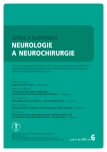Tuberous Sclerosis Complex in Children Followed from Neonatal Period for Prenatally Diagnosed Cardiac Rhabdomyoma – Two Case Reports
Authors:
B. Petrák 1; A. Gabera 2; H. Filipová 3; V. Tomek 4; A. Puchmajerová 5; L. Mrázková 6; A. Jahodová 1; M. Malíková 5; Michal Černý 7
; R. Vrtěl 3
Authors‘ workplace:
Klinika dětské neurologie 2. LF UK a FN v Motole, Praha
1; Dětská klinika, Krajská zdravotní, a. s. – Masarykova nemocnice v Ústí nad Labem
2; Ústav lékařské genetiky a fetální medicíny FN Olomouc
3; Dětské kardiocentrum 2. LF UK a FN v Motole, Praha
4; Ústav biologie a lékařské genetiky 2. LF UK a FN v Motole
5; Klinika zobrazovacích metod 2. LF UK a FN v Motole, Praha
6; Novorozenecké odd. s JIRP, Gynekologicko-porodnická klinika 2. LF UK a FN v Motole, Praha
7
Published in:
Cesk Slov Neurol N 2013; 76/109(6): 763-768
Category:
Case Report
Overview
Tuberous Sclerosis Complex (TSC) is an autosomal dominant neurocutaneous disorder with incidence of 1 : 6,000 and frequently occurring sporadic mutations in either TSC1 gene (type 1) or in TSC2 gene (type 2). Clinical manifestation is very variable with frequent formation of hamartomas and benign tumours. TSC is a multi‑system disorder characterized by defined diagnostic criteria – 11 major symptoms and nine minor ones. Benign cardiac tumour – rhabdomyoma – is one of the major symptoms and may be detected during prenatal period. We present two cases of children monitored from prenatal period for multiple cardiac rhabdomyomas and suspicious TSC diagnosis. TSC was diagnosed in both children based on clinical picture and later confirmed by DNA analysis. Both presented cases confirm the importance of follow‑up by a paediatric neurologist of newborns with prenatally diagnosed cardiac rhabdomyoma so that early TSC diagnosis can be made and neurological complications, including epilepsy, monitored and treated in a timely manner.
Key words:
tuberous sclerosis complex type 1, 2 – cardiac rhabdomyoma – epilepsy – magnetic resonance imaging
The authors declare they have no potential conflicts of interest concerning drugs, products, or services used in the study.
The Editorial Board declares that the manuscript met the ICMJE “uniform requirements” for biomedical papers.
Sources
1. Osborne JP, Fryer A, Webb D. Epidemiology of tuberous sclerosis. Ann N Y Acad Sci 1991; 615 : 125 – 127.
2. Curatolo P, Bombardieri R, Jozwiak S. Tuberous sclerosis. Lancet 2008; 372(9639): 657 – 668.
3. Roach ES, Gomez MR, Northrup H. Tuberous sclerosis complex consensus conference: revised clinical diagnostic criteria. J Child Neurol 1998; 13(12): 624 – 628.
4. Roach ES, Sparagana SP. Diagnosis of tuberous sclerosis complex. J Child Neurol 2004; 19(9): 643 – 649.
5. Crino PB, Nathanson KL, Henske EP. The tuberous sclerosis complex. N Engl J Med 2006; 355(13): 1345 – 1356.
6. de Vries PJ. Target treatment for cognitive and neurodevelopmental disorders in tuberous sclerosis complex. Neurotherapeutics 2010; 7(3): 275 – 282.
7. Bader RS, Chitayat D, Kelly E, Ryan G, Smallhorn JF,Toi A et al. Fetal rhabdomyoma: prenatal diagnosis, clinical outcome, and incidence of associated tuberous sclerosis complex. J Pediatr 2003; 143(5): 620 – 624.
8. Petrák B, Chaloupecký V, Černý M, Jahodová A,Lisý J, Kynčl M et al. Tuberózní skleróza a její komplikace u dětí sledovaných od novorozeneckého věku pro rhabdomyom srdce – deset let sledování. Česko ‑ slovenská pediatrie 2012; 67(5): 332 – 333.
9. Józwiak S, Kotulska K, Kasprzyk ‑ Obara J, Domanska ‑ Pakiela D, Tomyn ‑ Drabik M, Roberts P et al. Clinical and genotype studies of cardiac tumors in 154 patients with tuberous sclerosis complex. Pediatrics 2006; 118(4): e1146 – e1151.
10. Józwiak S, Kotulska K, Domanska ‑ Pakiela D, Loiszczyk B, Syczewska M, Chmielewski D et al. Antiepileptic treatment before the onset of seizures reduces epilepsy severity and risk of mental retardation in infants with tuberous sclerosis complex. Eur J Paediatr Neurol 2011; 15(5): 424 – 431.
Labels
Paediatric neurology Neurosurgery NeurologyArticle was published in
Czech and Slovak Neurology and Neurosurgery

2013 Issue 6
Most read in this issue
- Frontotemporal Lobar Degeneration from the Perspective of the New Clinical‑ Pathological Correlations
- Tuberous Sclerosis Complex in Children Followed from Neonatal Period for Prenatally Diagnosed Cardiac Rhabdomyoma – Two Case Reports
- Pineal Region Expansions
- Occipital Condyle Fractures
